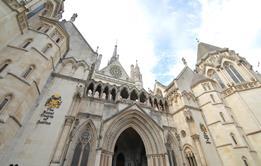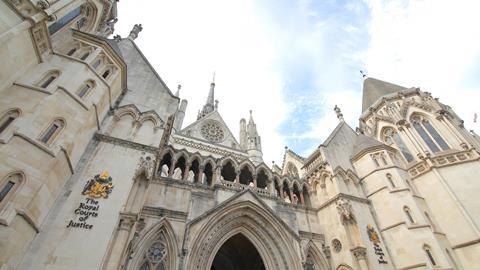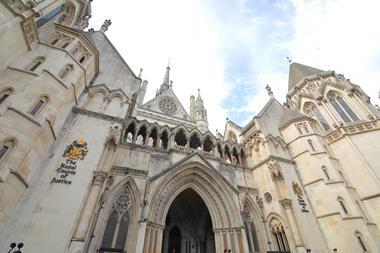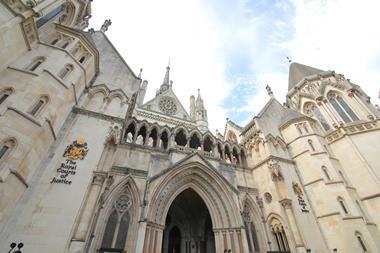A test case brought by the FCA against eight insurers could have significant consequences for insurers, brokers and policyholders. We report on the latest from the High Court…
16.37: The court has adjourned for the evening and will resume again in the morning at 10am. Lord Justice Flaux hopes that the insurers will complete their presentations tomorrow.
16.30: The court should regard Zurich’s other extensions, said Orr, when construing Zurich’s wordings. Orr wants the notifible diseases extension to be considered, although the FCA said this shouldn’t be considered as not all policyholders will have purchased this, or have been aware of it.
16.28: Danger in the vicinity of the premises could include a disease in the locality said Lord Justice Flaux. Orr agreed that the real thrust is in the local nature of the incident.
16.26: Orr said in Zurich 2, there is no way that pandemics could have been contemplated by the reasonable reader, contrasting the FCA’s view. The exclusion of pandemics in the notifible disease exclusion indicates Zurich’s stance. It is unlikely that these wordings would be side-stepped to consider another extension.
16.25: Orr said that Zurich’s wordings deal very much in the physical and physical damage - he said this is very far removed from the Covid-19 pandemic and the unprecendented measures implemented to deal with the pandemic. Orr described the FCA as trying to ‘fit a square peg in a round hole’.
16:22 The danger has to occur in the near location to the premises. The access means the the means to approach or enter, it is physical, said Orr. Examples could be a bomb scare or traffic accident, where the police need to shut an area and prevent access, this is what is insured, Orr added.
16.20: Zurich 1 and 2 policies are puchased by all seven categories of business - 84% however are in category 5, which did not have to close following the regulations. The policies were not all sold to SMEs - Zurich 1 is sold to mid-sized companies with substantial turnovers.
16.19: There is no blanket coverage, said Orr. This is clear by the notifible disease extension, he added. The clause limitations are fundamental, but ignored by the FCA.
16.17: The Zurich policies draw a clear distinction between the use of the premises and access to the premises. Likewise for ‘prevention’ and ’hinderance’.
16.15: The extension referring to notifible diseases has an exclusion for pandemics, which is why it is not included in the case.
16.14: The indemnity period refers to the period where the business’s results are affected, not the duration of the incident, explained Orr.
16.09: ‘Incident’ is defined as damage to the property, and ‘damage’ is described as physical loss, said Orr.
16.06: Zurich does not dispute the meaning of ‘civil authority’ - this includes central government.
16.05: Craig Orr now speaks on behalf of Zurich to discuss two clauses, both are public authority prevention of access clauses. The FCA does not reference Zurich’s notifible disease wordings, so these will not be addressed.
16.04: Lockey closes the discussion on Arch.
16.03: Adjustment exercises are far from straightforward, said Lockey.
15.59: Lockey said it could be impossible to determine the true causes of financial losses. Mnay businesses suffered a reduction in turnover prior to the regulations to close. The cause of this was the emergency. Even if premises was allowed to stay open, usual revenues would not have been achieved. Even those allowed to remain open, experienced a lack in revenue compared to last year - due to public fear, lack of travel, etc said Lockey.
15.58: Lockey said the FCA’s case has to go further, and that all causes linked to the insured peril has to be excluded.
15.53: Accepted that where businesses were advised, required and did close, that the policy has been triggered. But the calculation of indemnity poses questions and differs with the FCA stance. FCA wants to prevent Arch from adjusting claims payouts, however Arch believes these should reflect the fact that businesses were closed and there was less footfall. Policyholders have to prove a loss of revenue and that gross profit would have been earned despite the insured peril.
15.53: 38% of Arch policyholders are category 5, these were also not required to close and so were fully accessible.
15.50: Business owners and employees were not prevented from attending category 3 premises. FCA said access was prevented because it was more expensive for these businesses to operate because of social distancing and that footfall was less. Lockey said this is not the case and that the public could still shop there.
15.49: 70% of Arch retail policyholders are category 3, this is the category where there was no requirement to close, they were allowed to remain open. This cannot be denial of access therefore, said Lockey. These were expressedly told to remain open, he added.
15.45: Arch has few customers that are category 1 businesses. Access was restricted by 20 March advice and regulations following this. Lockey said businesses that did not offer a takeaway service before, but had to create a new business - ie a takeaway - as a result of the advice and regulations is permitted.
15.44: Lockey does accept that the following regulation after PM’s advice does qualify as action restricting access to certain types of premises.
15.40: The only advice which meets the requirement to prevent access is the advice given by the prime minister on 20 March and 23 March 2020 requiring certain businesses to be closed, said Lockey. Disagreement about the PM’s advice on 16 March - this advised people to work from home where possible and not to go to pubs and clubs. This, however, did not require the closure of any premises. The FCA deemed this a prevention of access, Arch disagreed.
15.39: The FCA said the clause should be read commercially - Lockey said this is looking at the wrong target. The insured peril is not driven by revenue effects.
15.39: Lord Justice Flaux highlighted the difference between prevention of access and hinderance of access.
15.38: Lockey said the FCA’s point that it doesn’t matter who cannot access the premises is a non-point. He added that the clause explained this plainly enough.
15.36: It’s enough that the advice recommends total closure, said Lockey. Mr Justice Butcher asked whether this is still the case if advice is ignored and Lockey said yes. Access to the premises for the purpose of conducting business is interrupted is what is covered.
15.34: The Arch clause is not triggered by restrictions on the public’s movements, depsite this impacting category 3 and 5 businesses. Those businesses were not advised or required to close, so there is no prevention of access.
15.33: The clause refers to the complete prevention of access, not part, contradicting the FCA’s stance, added Lockey. There cannot be a partial prevention.
15.31: Nothing short of government advice will suffice to prevent access to the premises said Lockey. The clause is concerned with access to the premises, not restrictions on the use which may be made of the premises. The clause only concerns prevention of access, not hinderance, explained Lockey.
15.30: The court resumes. Lockey said there is no dispute about the emergency and no dispute about the authority action - the issue is around access to the insured premises. Access to the premises refers to entry to the property.
15.20: The court is now breaking for 10 minutes before continuing with Arch’s defence, presented by Lockey.
15.18: The insured peril requires a qualifying emergency, authority action or advice and lastly the result of the authority action or advice is to deny access to the premise. The emergency is the first step, but this does not extend to pandemics. Lockey said the clause does not cover loss of gross profit due to an emergency, but it covers a specific type of denial of access.
15.05: Discussing the Arch 1 policy, which is the lead policy, Lockey says ’we have taken a sensible commercial construction to the clauses’
15.01: Arch not really interested in takeaways, in a legal sense, Lockey says
15.00: Next up, John Lockey QC, representing Arch Insurance
14.58: The effects of Covid are not insured until a restriction is imposed, Lord Flaux points out. Kealey says: They are one of the ingredients in a combination that amounts to an insured peril. If Covid were an insured peril - the government action, says Kealey
14.43: Public authority action causing prevention of access would be covered, Kealey says
14.40: If you assume that Covid-19 caused customers to stay away, that is a cause independent of the peril being insured for, Kealey says
14.36: His Lordship appears to be on mute… it’s been interesting seeing how new technology has been adopted for this case and the judges and lawyers are coping with it
14.34: The Amlin 3 policy refers to forges. In a lighter moment Kealey points out the difficulty of taking your furnace and anvil home from your premises. And there’s a general discussion involving the judges as to what a forge does
14.31: No room for conflating interruption with interference in the Amlin 2 policy, says Gaisman
14.22: The vicinity of a road in Islington will occupy a small area compared with a rural hotel in Northumberland. It depends on the context, Kealey says
14.16: We don’t live in a totalitarian state, Kealey suggests. The Prime Minister’s advice for staying at home did not need to be taken, it was voluntary. Controversial…
14.11: None of the government advice was mandatory or compulsory, Kealey claims. The advice from Boris Johnson had no statutory basis. The advice did not legally prevent access to premises, he adds
14.09: A business may be able to carry on away from the premises, if there is prevention of access, but that does not count as interruption, merely interference, Kealey says
14.05: If a situation arises that makes it more difficult to access the premises, that is hindrance of access and is not covered, Kealey argues
14.03: And we’re back. Ecclesiastical (and Amlin) QC Kealey is arguing on the point of access to premises being ‘prevented’ as opposed to ‘hindered’. The former would obviously more likely be covered than the latter
12.58: Mr Justice Butcher says that whatever causal signifiance is given to the word ’following’, it is not met by the disease within the 25 mile radius
12.50: He continues that the word ‘following’ should have the same causation requirement as ‘as a result of’ or ‘resulting from’
12.45: Kealey argues that the word ‘following’ has a causative meaning, and therefore must satisfy the but for test
12.40: Lord Justice Flaux says that something has to satisfy the but for test to be causal, and that he struggles to find a looser causal effect that satisfies the but for test
12.36: Mr Justice Butcher says that local restrictions may have been put in place because of local cases, even if they would’ve also been put in place because of wider cases at a later date, making the but for case irrelevant
12.23: Now its the time for Kealey to present on behalf of Amlin. First up, Amlin1
12.17: The essence of the FCA case is reversing out everything from the counter factual, Kealey says, but that the insurer case is that this is ‘unprincipled’
12.12: Kealey says that if a church was making £10 a week on average from its congregation and is now making nothing, that is a prima facie case under a business interruption policy. But if all the congregation had died of Covid-19, then they would have lost that income anyway, so there would be no payout under a business interruption policy
12.10: Kealey argues that customers may have already decided to not visit businesses even if the lockdown restrictions were not put in place, so any loss of income may have occured irrespective of the government restrictions
12.07 Business interruption losses are a highly complex area of administration and insurance and disputes arise often between insured and insurers as to what losses have genuinely been sustained as a result of a peril or due to any event, Kealey says
11.57 Kealey gives the example of the church receiving £1000 per week via its collection plate, and the church was subsequently closed and so each week the church did not receive this amount. The church would establish an emergency that prevented or hindered access, so no-one could attend and make donations. Then Kealey stresses that the insured peril had not only operated but caused the church a £1000 loss per week, however if this situation is on a national scale and has not just affected the church, then this is a wider issue.
11.56 Lord Justice Flaux asks why the loss of income for the church isn’t covered by the insured activities
11.52 Kealey says that loss of income had nothing to do with the church being closed. The church will have to identify what its loss of income is.
11.45 Kealey talks of as an example church that stopped monthly donations due to Covid- but the previous year, the church was closed and donated electronically. Edelman previously said it is not recoverable. But if you assume no government action it should be recoverable, so the insured peril is not the trigger. Kealey suggests reversing the closure instead of reversing loss from emergency. 19
11.43 Kealey says that is not what Ecclesiastical agreed to insure, the more elements in causation the narrower the insured peril.
11.37 In regards to ’access prevention’ it is access prevention by government due to an emergency Kealey argues, he then points out two things the insured peril is not the emergency and the insured peril cannot become the emergency by the back door.The peril cannot be converted just because it is mentioned or by the backdoor of the facts. This is something Gaisman also mentioned. Kealey says this is a “highly controversial statement” as government intervemtion is not just part of any one particular strategy.
11.32 Speaking about causation, Kealey gave an example of rats and causation. In Ecclesiastical’s case, scope of cover and trigger has to be construed by the cause.
11.30 And we are back Kealey talks about ’causation’ and suggests that Edelman was misleading the court. Lord Justice Flaux disagrees on the latter.
11.21 The court is taking a short break but will resume shortly
11.14 Kealey questions why the word “competent” was even used in the first place
11.13 Lord Justice questions why it says “competent local authority”?
11.04 It is apparent from CCA (2004) that the architecture of the legislation requires action by central government, local government and/or other authorised persons ie: justices of the peace. The legal background shows that it has never been the case that the only authority competent to act in relation to infectious diseases is an local government authority. Secondly the power to make the most powerful and intrusive orders lies with courts particularly magistrates, and thirdly central government has always been an authority with competence to act with local and national public health matters.
11.00 In regards to ’power to make emergency regulations’, Kealey says the emergency regulations specify that is anything protecting human life or injury.
10.53 Kealey says the position of the legislative background involving Ecclesiastical, the most significant is this context is the Civil Contingency Act (2004), the infectious disease carve out is due to an emergency that could endanger human life or neighbouring property. Speaking about the meaning of the term ‘emergency’ he notes it is ”an event or situation which threatens serious damage to human welfare in UK.”
10.50 The legislative background was reasonably available to the parties Kealey stresses, contrary to what the FCA says, Ecclesiastical does not have to show that the legislative framework was actually known by the insurer and the insured, ”that is wrong by a matter of legal principle”.
10.40 Kealey says you do not treat this clause as an exemption clause, it is there to define the scope of the cover. Speaking about Ecclesiastical and ‘what is not covered’ and in conjunction with specified disease clause, what has been carved out is closure or restriction of use of premises due to advice of local government where ’competence’ means the local authority with competence in the relevant locality. The FCA suggests that our preferred meaning is very challenging, but the challenge for Ecclesiastical is “more apparent than real” because it is obvious that there was an infectious disease carve out from prevention of access coverage; and clear connection between the infectious disease carve out and specified disease coverage clause. So, it is apparent that it was recognised. These clauses should be construed against the relevant legal background.
10.33 Now we hear from Gavin Kealey again, he notes the ’specified disease coverage clause’ and highlights the left hand column where the specified diseases are identified, adding that most of them are notifiable diseases. What is covered is any occurrence of specified disease being contracted by a person on premises or any person within a 25 mile radius. Not just any occurrence covered, has to be one that causes a restriction within the context or advice of the competent local authority.
10.27 Gaisman poses this question to FCA: ”What possible reason could there be for both parties wanting the trends clause relating to claims for material damage and non-damage business interruption?” Unless there is an answer to that, then this is a non-point. He urges the FCA to answer as this trends clause works both ways.
10.25 Lord Justice says if the business is closed, it does not need any action from the public authority for that as the action precedes it.
10.23 Gaisman draws attention to the public authority clause, he questions public authority action and causation and asks once the interruption has happened, does that take over? He said that ”the FCA is in a world of its own.”
10.08 Trends clauses - this completely undermines fact that these are the insureds, Gaisman says that there is no evidence that these clauses have caused any difficulty or if loss adjusters were appointed, but none of these change the meaning of the contracts. Nobody has attempted to do this excercise of working out the loss. There is no basis for assuming that the inquiry of what has caused the loss is so difficult that it cannot be embarked on, he adds. If the insured can prove this loss then the evidential burden can shift to the insurer
10.00 Jonathan Gaisman QC kicks off with Hiscox’s defence, he says if the insured peril is removed it could lead to a ”hypothetical professional” but the counter factual from Hiscox is far from artificial he stresses
Missed yesterday’s proceedings? You can catch up on all the action from the fourth day of the hearing here
Read more…
Not subscribed? Become a subscriber and access our premium content

Hosted by comedian and actor Tom Allen, 34 Gold, 23 Silver and 22 Bronze awards were handed out across an amazing 34 categories recognising brilliance and innovation right across the breadth of UK general insurance.
FCA business interruption test case

- 1
- 2
- 3
- 4
- 5
 Currently
reading
Currently
reading
FCA business interruption test case: Day 6 - as it happened
- 7
- 8



































































No comments yet